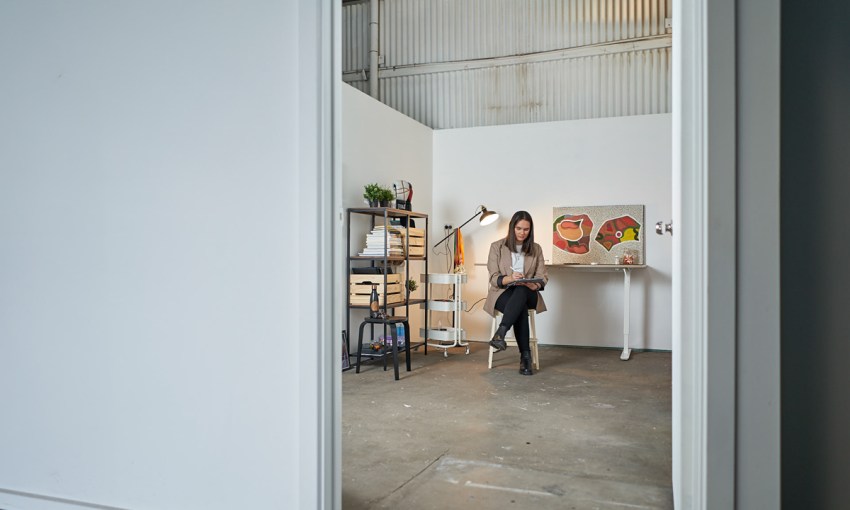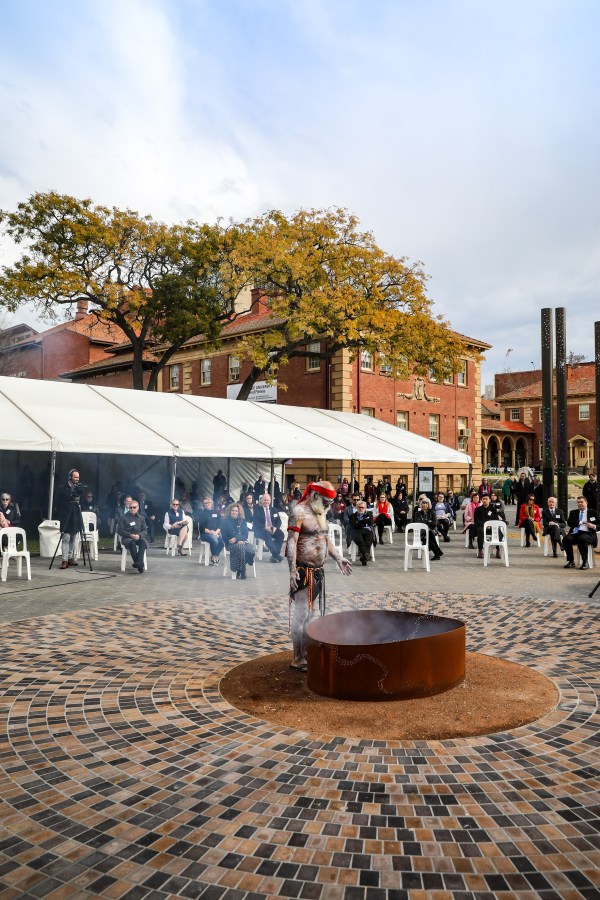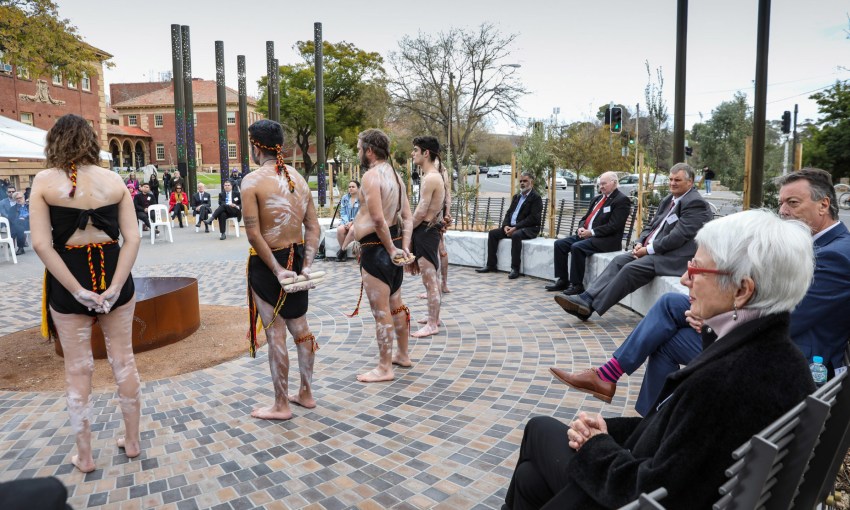CityMag has put South Australia’s higher education sector under a microscope, to see how universities are training and supporting First Nations staff and students, and how they're managing the future of Indigenous engagement with their institutions.
‘There’s still work to do’: A look into First Nations experience in Adelaide’s universities
Grace Mayor is a proud Gudang and Upai Purri woman living in metropolitan Adelaide while completing a Bachelor of Laws at the University of Adelaide.
“I’ve always been an arguer,” she tells CityMag, “and I’d like to focus on Indigenous youth or being a criminal defender – or human rights.”
The University of Adelaide’s Karnkanthi Indigenous Education Program helps connect First Nations high school students to the institution, and assisted Grace in entering tertiary education.
When she was in Year 12 and needed a laptop, the scholarship provided funding to buy one. Now, as a second-year student, the University of Adelaide’s Wirltu Yarlu Indigenous student program offers emotional support.
“If I’ve experienced something on campus, I can come here and have a yarn with people who work here,” Grace says.
CityMag asks what would warrant a yarn, and Grace mentions previous encounters with peers.
“There’s been a few instances,” she explains, “of comments and jokes.
“After I mention that I’m an Indigenous person, [the students] are like ‘There’d be so many scholarship options for you,’ or ‘What welfare do you receive?’
“It’s definitely un-motivating in moments, but it’s just like whatever. It’s a problem, but through my work I can hopefully make a change somehow.”
A spokesperson for the University of Adelaide says the university does not tolerate any form of racism or discrimination and has received no reports of racism made by Indigenous students in the last year.
They did confirm there are 300 First Nations students currently enrolled at the university, of a total of 27,000 students, meaning just 1.1 per cent of the University of Adelaide students are Indigenous.
The University of Adelaide’s Pro Vice Chancellor (PVC) of Indigenous Engagement, Noongar man Shane Hearn, says the University of Adelaide provides numerous avenues of support for Aboriginal students, but the most important thing the institution can do is ensure there is structural support so these students complete their studies at the same rates as everyone else.
“Universities play such a significant role in social justice and social inclusion,” Shane tells CityMag.
“[But] they don’t always do it well, and that’s why positions like PVC [of Indigenous Engagement], and other relevant Aboriginal positions and academics, are so important to the design and delivery of service in these institutions and universities.”
In a year characterised by historical events, including the Black Lives Matter movement, which prompted Australia to examine its treatment of Aboriginal and Torres Strait Islander people, CityMag has delved into how the university sector, an industry responsible for educating and uplifting the nation’s next thought leaders, supports Indigenous Australians.
We examined South Australia’s top universities – the University of Adelaide, the University of South Australia and Flinders University – and how they support First Nations students and staff, and engage with First Nations knowledge.
But first, a lay of the land
Universities Australia connects all 39 major national higher education institutions, and develops policies across social, economic and cultural issues in the sector.
Their most recent Indigenous Strategy pledged to improve enrolments and performance among Indigenous Australian students and staff; increase engagement of non-Indigenous people with First Nations knowledge and perspectives; and improve the university environment for First Nations people.
This is because, although in the last decade there have been improvements, “enrolments have been low, attrition rates high and Indigenous staff remain few,” the document says.
“Universities have been part of a wider pattern of disadvantage and discrimination in Australia.”
And although nearly 20,000 Aboriginal and Torres Strait Islanders across the country are now studying in higher education, Universities Australia chief executive Catriona Jackson says more needs to be done.
“Barriers remain, and it’s not always easy to see a pathway to uni – particularly for those who are the first in their family to consider higher education,” she said via a statement.
The student experience
It’s been 54 years since Charles Perkins became the first Aboriginal person to graduate from an Australian university, and although there has been an enormous increase in student numbers since, the university experience is still not equal between Indigenous and non-Indigenous students.
Carly Tarkari Dodd is a Kaurna, Narungga and Ngarrindjeri artist based in Adelaide. She started studying a Bachelor of Visual Art at UniSA in 2017, and dropped out a year later.
Carly tells CityMag she felt confined by the curriculum which leaned towards “one culture, white culture,” she says. She also experienced what she felt was discrimination on campus.
“I always find this, especially in high school as well, that once teachers or people, in general, find out I’m Aboriginal, they start treating me differently,” Carly explains.
“They’d treat me differently to other students, and when I’m researching something, they’d point me into the direction of Aboriginal artists and not other [non-Indigenous] people.”

Carly Tarkari Dodd. Picture: Sam Roberts
A UniSA spokesperson says the institution has a zero-tolerance policy towards racism, and in 2020 there were no reports of racism made by Aboriginal Australian students.
The spokesperson added there were 500 First Nations students enrolled in 2019. Compared to the overall cohort of 35,330 students, this means Indigenous students make up 1.4 per cent of the total body.
Flinders University reports a similar figure, with a spokesperson confirming there were 362 Indigenous students enrolled in 2018, from an overall student body of 26,082, making 1.3 per cent.
Carly believes her university experience would have improved if Wirringka Student Services, a UniSA support service tailored to help Aboriginal and Torres Strait Islander students, maintained a stronger connection to her throughout her studies.
“It would be better if they checked in a bit more,” Carly says.
Leata Clarke manages Wirringka Student Services, and says the service helps students from the point of application to graduation.
“At the end of the day, my approach is I just want every Aboriginal student to have the opportunity to go to university,” Leata tells CityMag.
“I think it really comes down to breaking the cycle of poverty, giving them the chance to contribute economically to society.”
Leata says there are barriers preventing First Nations students from applying to and completing university, including not having access to technology, role models, and the financial means to support themselves while living independently.
“I think we can always improve, absolutely, and I think that obviously comes with more funding, more staffing, more programs, more innovative ways of engaging,” she says.
Professor Irene Watson is the PVC of Aboriginal Leadership and Strategy at UniSA, and says since the university was established in 1991, it has maintained a strong foundation to support social justice and First Nations education.

Professor Irene Watson. This picture: supplied
In 1985, Irene was the first Aboriginal person to graduate from the University of Adelaide with a law degree, and, throughout her time studying, she admits to encountering subjects which drew upon racist ideas, such as the notion of the “romantic savage”.
“We haven’t fully recognised Aboriginal peoples as First Nations peoples and what that means,” Irene says.
“We’re still in this process of assimilating Aboriginal people into institutions that are really founded on and enshrined in systemic racism. There’s still a lot of work to be done.
“[And] for the majority of our Aboriginal students, they do it harder because of the fact that they’re a minority.”
Irene says one per cent of UniSA staff identify as Aboriginal or Torres Strait Islander, and the university’s target is three per cent.
Achieving this low target would still leave Irene feeling “exhausted,” because when there’s such a low level of representation to begin with, some First Nations staff become over-burdened.
“It makes me tired because the few Aboriginal people we have in the space have additional workload implications because you become the go-to person for everything,” she says.
“I would say many of our Aboriginal staff are positioned in that way.”
The staff experience
First Nations employees make up 2.9 per cent of South Australia’s total working university cohort, according to the most up-to-date Federal Government data.
Among that 2.9 per cent is Arabana and Narungga woman Lakota Milera-Weetra, who has been a paid trainee with the University of Adelaide’s Mobile Language Team for two years.
Although Lakota experienced a range of racism in primary and high school, she says she feels supported by her colleagues at the university and has not received any noticeable racist or discriminatory remarks.
But there have been moments of discomfort.
“I’ve never felt that discrimination. But even if I do, I’ve got a pretty good wall of protection,” Lakota tells CityMag.
“But we were on Country once and a [non-Indigenous] colleague wanted to test the air pressure on the tyres, but I’d already done it with my family.
“I was like, ‘Okay, how much time have you spent out here and how much time have my family spent out here?’ … That one incident felt a bit insulting.”
The Mobile Language Team has written specific by-laws prioritising employing Indigenous staff over non-Indigenous staff, Lakota says, which to her signals the university supports increasing the level of Indigenous representation.
But throughout her time in the higher education sector, Lakota’s witnessed Indigenous employees missing out on job promotions while lesser-qualified non-Indigenous staff were elevated instead.
“It’s a bit shit,” Lakota says, “because you often see a blackfella who’s up here but then there’s always a white person that’s further above.”
She’s also noticed some Western cultural norms, such as deadlines, can become a point of tension with communities she works with, and believes flexibility and communication between the bodies could help.
This, coupled with the fact these communities may not be interested in working with a “white institution that has historically not been so kind to Indigenous peoples,” she says, can make her job difficult.
Lakota says many communities perceive the University of Adelaide as belonging in the same world as the South Australian Museum, which has made it difficult for Lakota to personally to access artifacts from her own heritage.
She, and students Grace and Carly, believe their university experiences could be enhanced with more First Nations workers and academics in the sector. They’re unsure whether change can occur the top down via the administration, or from the ground up among students.
Jason Brailey is a Tharawal man and a Senior Manager of Indigenous Education at RMIT University in Melbourne. He is also the treasurer of the National Aboriginal and Torres Strait Islander Higher Education Consortium (NATSIHEC).
NATSIHEC aims to advance the position of Aboriginal and Torres Strait Islander people in higher education and consults with Universities Australia and other key stakeholders on strategies and policies.
Jason Brailey tells CityMag racism is still prevalent and a significant barrier for some in the university sector, and “people need to start just speaking real truth,” he says.
“We’ve been in this game for 50 years and the conversation about racism and its impacts are not going really too much further than where we were at the start,” he said.
Jason believes the student’s success in Australia’s higher education sector is “patchy” and depends on certain structures.
This includes ensuring pathway programs and initiatives to get students in the door are in place, but are accompanied by Indigenous engagement plans and implementation plans. Additionally, there must be consequences if targets aren’t met.
“A couple years ago, when I was at Monash [University], the retention rates were actually tracking higher than non-Indigenous [students], which is quite a huge accomplishment,” Jason says.
“But it was also obviously to do with the entrance requirements and the rigidity around that.”
Jason doesn’t prioritise retention rates over enrolments, as he believes universities should be in the business of creating opportunities rather than strictly supporting graduating students.
“We don’t want to set people up to fail,” he says.
He is also aware of how challenging it is for Aboriginal or Torres Strait Islander students to participate in university life and culture, because, the way he sees it, they are excluded as soon as they enter the room.
“When students enter the classroom they can expect that knowledge systems, all of the things that their parents have ever taught them, anything that their parents have said in terms of values or what matters in the world, will be left at the door, because what they’re being taught is a Western, white system,” he says.
First Nations knowledge in the curriculum
CityMag meets University of Adelaide PVC Shane Hearn a month after the University of Adelaide unveiled the Kaurna Learning Circle, which is an on-campus site designed to share Indigenous knowledge among staff and students.
The structure itself is located near the University of Adelaide footbridge and includes a smoking pit for ceremonies and a long marble seated area for crowds.

Uncle Fred Agius leads a smoking ceremony at the Kaurna Learning Circle, University of Adelaide. Picture: Russell Millard
Shane said in a press release the Kaurna Learning Circle will enhance students’ understanding of First Nations knowledge.
A month after its unveiling, CityMag asks Shane what First Nations knowledge will be shared at the site, and what knowledge is taught at the university.
He says there are “16 to 24” formal subjects focussing on Indigenous knowledge at the University of Adelaide, however, academics might pepper facts throughout other classes.
As we’ve heard from all the representatives CityMag spoke to, there’s room to grow.
“We also want to build a global alliance on Indigenous knowledges and research,” Shane says.
“The first stage is building our own platform and our unique Aboriginal knowledges as a program, and then connecting it to other areas. We’ve been amazed at how many people want to do this globally.”
Neither Flinders University’s PVC of Indigenous Engagement, Simone Tur, or UniSA’s PVC of Aboriginal Leadership and Strategy, Irene Watson, could tell us the number of subjects dedicated to First Nations knowledge in their institutions’ curricula.
However, Simone says Flinders University has some humanities, arts and social sciences subjects incorporating these perspectives, and Irene says UniSA has a master’s program specifically on Aboriginal studies, as well as other units.
“But of course, it’s really important from our perspective, that we have quality [resoures] so the work that goes into that is really important,” Simone says.
Irene agrees, saying in 2005 UniSA committed to embedding more First Nations knowledge into the programs.
“But there’s still a lot of work to do” she says.
Where to from here
Throughout this investigation, CityMag heard differing views on the reality of the experience of First Nations people in South Australian universities.
But, as Jason Brailey put it, universities too often only deal with those who are university-ready. This can be a self-congratulatory perspective that may be distracting from some of the larger and more difficult-to-solve issues faced by Australia’s Indigenous communities, such as racism and structural disadvantage.
“We’ve still got the highest incarceration rates in the world,” Jason says, “and we’ve still got the highest rates of adult functional illiteracy in the country.
“We’ve still got people dropping dead at 60 instead of 85, and there are all these fundamental kinds of issues where we’ve fallen down as a society.
“This fixation on the tertiary education stuff in some ways narrows our world, and enables people to create blind spots that make these bigger issues somewhat invisible, and create narratives of ‘Aboriginal advantage through scholarships and other opportunities’ at universities.
“Things have gotten better in universities… through a lot of hard work, and through a lot of perseverance.
“But that doesn’t necessarily mean that our whole community is healthier or better for that fact.”

From Adelaide’s Black Lives Matter protest in July. This picture: Tim Lyons
If this story raised issues for you, call LifeLine on 13 11 14. Beyond Blue and headspace are other national organisations that offer comprehensive mental health support.




